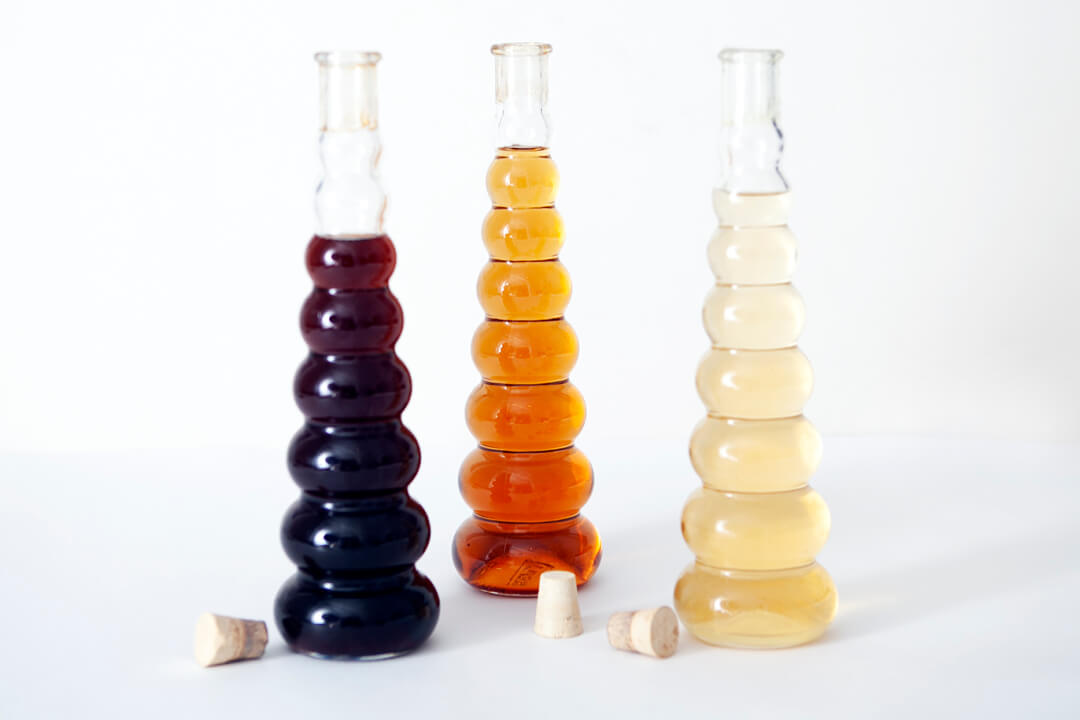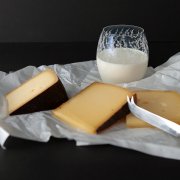Experimenting for more enjoyment
Vinegar is usually overshadowed by oil. Vinegar does not deserve this.
The well-known vinegar triad
These three types of vinegar can be found in almost every kitchen: white wine vinegar, aceto balsamico and vinegar essence. The latter, however, is a chemical product made from purified acetic acid and is intended for cleaning in the kitchen when limescale stains need to be removed or to effectively remove mold that has developed under fruit or vegetables in the vegetable drawer.
Thanks to many celebrities (or paid influencers) who have suddenly discovered apple cider vinegar and praise it as a way to get or stay slim, apple cider vinegar has now also been added to many kitchen cupboards.
Whether apple cider vinegar actually helps to lower blood lipid levels and reduce food cravings has not yet been the subject of representative studies. Subjectively, it is good to take a spoonful of apple cider vinegar from time to time. The acidity of the vinegar has an antibacterial effect, but is unfortunately bad for tooth enamel in undiluted form. Dissolved in a glass of water, the taste takes some getting used to and the effect is naturally reduced.
We therefore refrain from making any recommendations – it can always be used instead of white wine vinegar in a classic vinaigrette.
Apricot vinegar from the Netherlands
A gift from a friend from the Netherlands also made us realize that white wine vinegar and balsamic vinegar alone deprive us of many flavours. The apricot vinegar from the Netherlands is a lovely fruity, sweet and sour component that adds a welcome flavor component to a simple ruccula salad with feta.

For the production of fruit vinegars, as is often the case in life, there is a longer way and a shortcut. Ripe fruit with added yeast converts the sugar into alcohol. After longer storage, the alcohol turns into acid. You may have already experienced this with a wine that is well past its cellar life. The long process means long storage time and effort. The shortcut: vinegar mixed with fruit syrup.
The difference lies in the price and the ratio of fruit sweetness to acidity. A carefully aged vinegar is a delicacy and can be enjoyed in a liqueur glass – but you have to look for it.
In our experience, high-quality vinegar is easier to taste than high-quality olive oil.
The city of Modena and the Emilia Romagna region
Traditional aceto balsamico is a vinegar that has come a long way. It takes many years for the vinegar to become a precious essence. It is made from the must of Trebbiano, Sangiovese and Lambrusco grapes. Twelve years is the minimum storage time for a traditional acetone balsamic vinegar.
Similar to whisky, the barrels are also involved in the subsequent taste. The vinegar is stored in barrels made from cherry, chestnut or oak wood until it turns into a viscous essence.
 Balsamic vinegar barrels in Modena, Emilia Romagna, Italy © Alamy Stock Photo
Balsamic vinegar barrels in Modena, Emilia Romagna, Italy © Alamy Stock Photo
The important terms on the packaging that are worth looking for are: Traditional Balsamic Vinegar of Modena or Traditional Balsamic Vinegar of Region Emilia. Only if these two terms appear on the bottle is it a vinegar that has been elaborately produced and stored for many years and, like champagne, has a regionally protected designation of origin,
If only Balsamico Vinegar of Modena can be found on the bottle, it is a vinegar that consists of a mixture of longer and shorter aged wine vinegar and only needs to be stored for a minimum of 60 days.
You can definitely taste the difference. A traditional balsamic vinegar is a delicious essence that can be enjoyed on its own with Parmesan cheese as a side dish or on a piece of fine beef. But this vinegar also makes sense on an excellent vanilla ice cream.

The exact designation of origin is so important because a vinegar producer from Baden enforced before the European Court of Justice in Luxembourg that only the full designation of origin “Aceto Balsamico di Modena” or “Aceto Balsamico di Emilia Romagna” is protected. Since 2019, vinegar produced in other countries or regions may therefore also be called Aceto Balsamico.
White and red balsamic vinegar
In addition to the long-matured dark red aceto balsamico, there is also a white aceto balsamico, or white wine vinegar, which tastes less spicy but more fruity than the dark aceto balsamico. It can be used, for example, to marinate chicken or pork before grilling.
Which brings us back to the familiar vinegar triad in the kitchen. Simply expand it.
Photography © GloriousMe 2024
#Advertising #ProductPlacement #IndependentRecommendation #BecauseWeLoveIt




